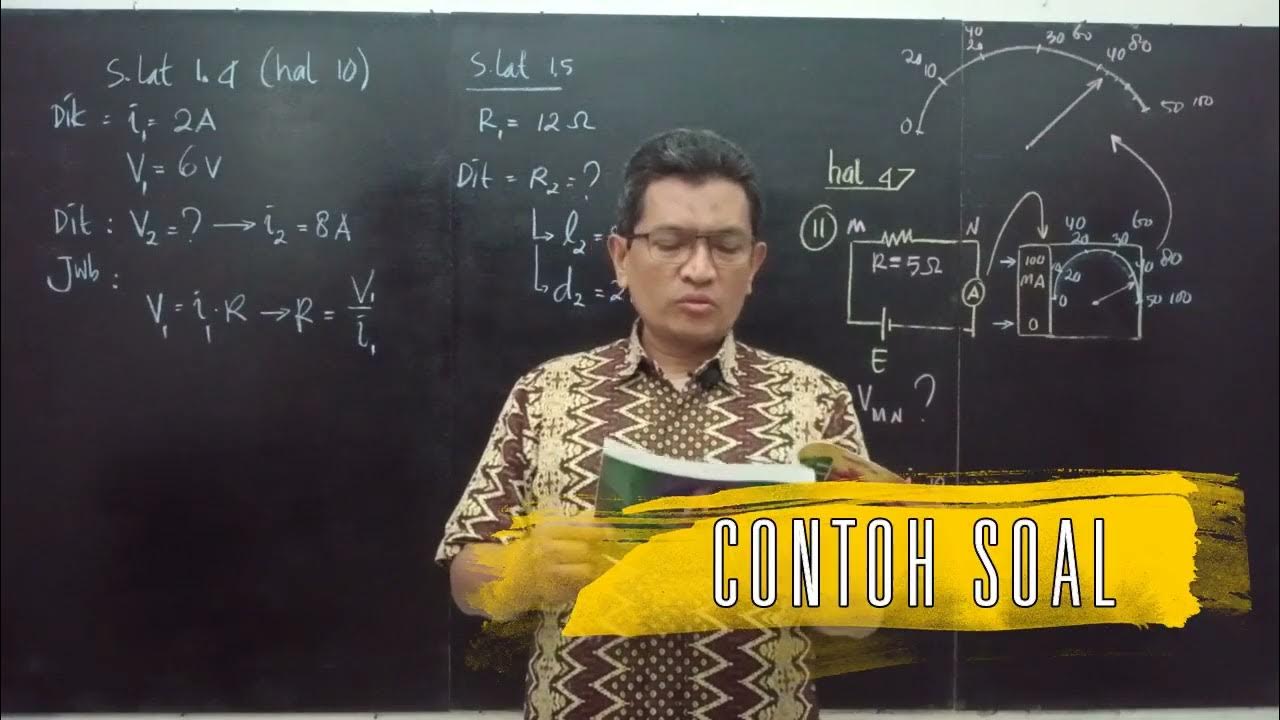Física - Eletrodinâmica: 2a lei de Ohm
Summary
TLDRIn this lesson on electrical resistance, the instructor explains how resistance is influenced by three key factors: the length, thickness, and material of the conductor. Longer wires increase resistance, while thicker wires reduce it. The material of the conductor, defined by its resistivity, also plays a critical role. The formula for calculating resistance, R = ρ × (L/A), is introduced. Practical applications, such as potentiometers and their role in controlling current, are discussed to illustrate how resistance affects everyday devices like electric showers and audio equipment.
Takeaways
- 😀 Electrical resistance is the difficulty experienced by electric current in passing through a conductor.
- 😀 A resistor is a device specifically designed to offer electrical resistance in a circuit.
- 😀 The resistance of a conductor is influenced by three main factors: length, cross-sectional area, and material.
- 😀 The resistance of a conductor increases with its length. The longer the conductor, the higher the resistance.
- 😀 Resistance is directly proportional to the length of the conductor: longer wires have higher resistance.
- 😀 A conductor's cross-sectional area (thickness) affects its resistance. Larger areas result in lower resistance.
- 😀 The relationship between resistance and area is inversely proportional: thicker wires have less resistance.
- 😀 Using the analogy of a road, more lanes (larger cross-sectional area) allow more cars (electrons) to pass, reducing resistance.
- 😀 The material of the conductor also influences resistance. Conductors made of materials with higher resistivity offer more resistance.
- 😀 Resistivity is a property of materials that quantifies how much they resist the flow of electrical current. It is a material-specific value.
- 😀 The formula for calculating electrical resistance is R = ρ * L / A, where ρ is resistivity, L is length, and A is the cross-sectional area.
- 😀 A potentiometer (or rheostat) is a device that adjusts electrical current in a circuit by changing the length of the resistor.
- 😀 By increasing the length of the resistor in a circuit, the resistance increases, causing a decrease in current.
- 😀 Potentiometers are widely used in everyday devices like shower heaters and volume controls, adjusting resistance to modify current flow.
Q & A
What is electrical resistance?
-Electrical resistance is the difficulty that electrical current encounters as it passes through a conductor. It is caused by collisions between the moving electric charge and the atoms in the material.
What is the role of a resistor in an electrical circuit?
-A resistor is a component used in electrical circuits to provide resistance, controlling the amount of current flowing through the circuit by hindering the movement of electrical charges.
What are the three factors that influence the resistance of a conductor?
-The three factors that influence the resistance of a conductor are its length (L), its cross-sectional area (A), and the material from which it is made, which is characterized by its resistivity (ρ).
How does the length of a conductor affect its resistance?
-Resistance is directly proportional to the length of the conductor. The longer the conductor, the higher the resistance, because there are more atoms for the current to collide with, slowing down the flow of electric charge.
What is the relationship between the cross-sectional area of a conductor and its resistance?
-Resistance is inversely proportional to the cross-sectional area of the conductor. A larger area allows more charge carriers (electrons) to pass through simultaneously, reducing the resistance.
Why does increasing the thickness (area) of a conductor decrease its resistance?
-Increasing the thickness of a conductor provides more space for charge carriers to pass through simultaneously, which reduces the number of collisions between electrons and atoms, thereby reducing the resistance.
How does the material of a conductor affect its resistance?
-The material of a conductor affects its resistance based on its resistivity (ρ). Materials with higher resistivity offer more resistance to the flow of current, while materials with lower resistivity allow current to flow more easily.
What is resistivity, and how is it measured?
-Resistivity is a material property that quantifies how strongly a material resists the flow of electric current. It is measured in ohm-meters (Ω·m) in the International System of Units (SI).
What equation relates resistance, resistivity, length, and cross-sectional area of a conductor?
-The equation that relates these factors is: R = ρ × (L / A), where R is the resistance, ρ is the resistivity, L is the length, and A is the cross-sectional area of the conductor.
What is a potentiometer and how does it use the concept of resistance?
-A potentiometer is a device that allows the user to adjust the resistance in a circuit, typically by changing the length of the resistor that current passes through. This adjustment modifies the current in the circuit.
How does a potentiometer work in a simple electrical circuit?
-In a simple circuit, a potentiometer allows the user to select different lengths of a resistor to be part of the current path. The longer the resistor, the higher the resistance, and the lower the current flowing through the circuit.
How is the concept of electrical resistance applied in practical devices like electric showers?
-In electric showers, a potentiometer is used to adjust the resistance in the circuit, allowing the user to control the water temperature by regulating the current flowing through the heating element. This is typically done by selecting different resistor lengths to alter the resistance.
Outlines

هذا القسم متوفر فقط للمشتركين. يرجى الترقية للوصول إلى هذه الميزة.
قم بالترقية الآنMindmap

هذا القسم متوفر فقط للمشتركين. يرجى الترقية للوصول إلى هذه الميزة.
قم بالترقية الآنKeywords

هذا القسم متوفر فقط للمشتركين. يرجى الترقية للوصول إلى هذه الميزة.
قم بالترقية الآنHighlights

هذا القسم متوفر فقط للمشتركين. يرجى الترقية للوصول إلى هذه الميزة.
قم بالترقية الآنTranscripts

هذا القسم متوفر فقط للمشتركين. يرجى الترقية للوصول إلى هذه الميزة.
قم بالترقية الآن5.0 / 5 (0 votes)






